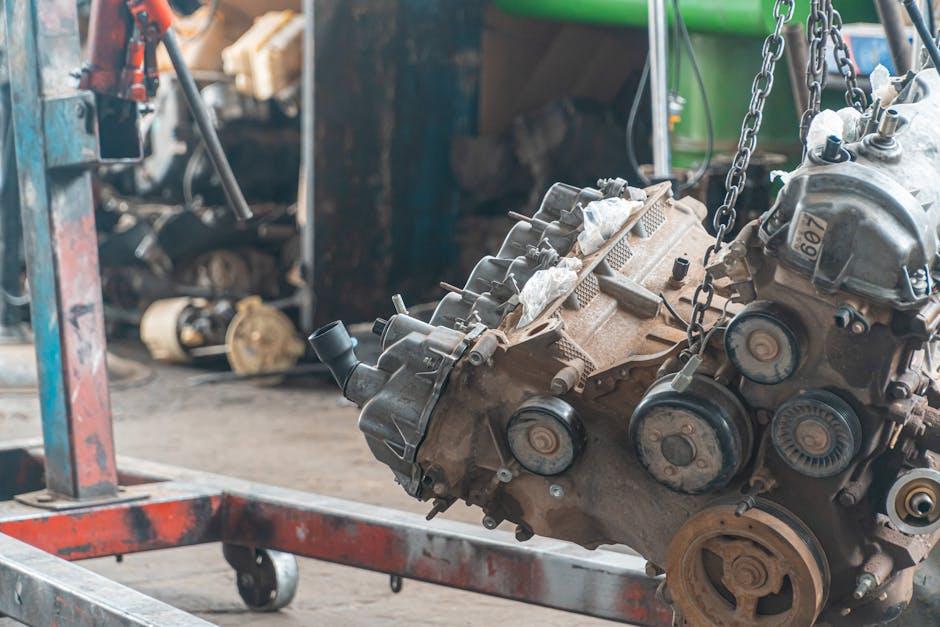Beneath every smooth ride lies a suspension system working tirelessly to keep you comfortable and in control. Yet, like any intricate mechanism, suspensions can wear down over time, stealthily affecting your vehicle’s performance and safety. Knowing when your suspension needs repair isn’t always obvious, but recognizing the subtle signs can save you from costly damage and ensure your journeys stay steady. In this article, we’ll explore the key indicators that signal it’s time to give your suspension the attention it deserves.
Table of Contents
- Signs Your Ride Feels Off: Identifying Suspension Issues
- Unusual Noises That Signal Trouble in Your Suspension
- How Uneven Tire Wear Can Reveal Suspension Problems
- The Impact of Poor Handling and Steering on Safety
- When to Consult a Professional for a Suspension Check
- Simple DIY Tests to Evaluate Your Suspension Health
- Q&A
- In Conclusion

Signs Your Ride Feels Off: Identifying Suspension Issues
When your vehicle no longer glides smoothly over bumps but instead feels like it’s bouncing or swaying excessively, it’s a clear warning that your suspension might be struggling. Other common indicators include an unusually harsh ride, where every pothole or road imperfection feels magnified, or a noticeable dip on one side of the car, hinting that shock absorbers or springs may be failing. You might also hear creaking noises during turns or braking, which often signal worn components within the suspension system.
Keeping an eye out for these telltale signs can save you from costly repairs down the line. Look for symptoms such as:
- Uneven tire wear—signifying poor suspension alignment or worn parts;
- Steering wander or pull—where the vehicle drifts to one side;
- Excessive body roll around corners;
- Visible leaks of hydraulic fluid on shocks or struts.
| Symptom | Possible Cause | Impact on Ride |
|---|---|---|
| Uneven Tire Wear | Misaligned Suspension | Reduced Grip & Safety |
| Excessive Bouncing | Worn Shock Absorbers | Unstable Handling |
| Pulling to One Side | Damaged Springs or Bushings | Steering Difficulty |

Unusual Noises That Signal Trouble in Your Suspension
Hearing strange sounds coming from your vehicle’s undercarriage can be an early warning sign that your suspension system is under distress. Among the most common auditory clues are clunking, squeaking, and rattling noises. These sounds often occur when driving over bumps, turning corners, or braking and can indicate worn-out shock absorbers, loose components, or damaged bushings. Ignoring these noises not only compromises your ride comfort but may also escalate into more costly suspension failures.
To better understand what each noise might mean, consider this quick reference:
| Noise Type | Potential Cause | What to Do |
|---|---|---|
| Clunking | Loose or worn ball joints, control arms | Visit a mechanic promptly |
| Squeaking | Dry or cracked bushings | Lubricate or replace affected parts |
| Rattling | Broken or loose shock absorbers | Inspect and tighten or replace shocks |
Listening attentively to these unusual sounds, combined with routine suspension checks, ensures that you catch problems early and maintain a smooth, safe driving experience.

How Uneven Tire Wear Can Reveal Suspension Problems
When examining your tires, uneven wear patterns can act as a silent alarm for problems lurking in your suspension system. If one tire shows excessive wear on the inside edge while the other looks relatively fine, it’s a clue that components like control arms or ball joints might be misaligned or deteriorating. This occurs because a malfunctioning suspension cannot maintain proper tire contact with the road, leading to abnormal pressure distribution and, consequently, uneven tread wear. Paying close attention to these wear patterns can save you from costly repairs by catching suspension issues early.
Here’s what to watch for in your tire wear to pinpoint potential suspension faults:
- Feathering: Corners of the tire tread look rounded or smooth on one side – often indicating worn steering or suspension parts.
- Cupping or Scalloping: Tires have high and low points creating a bumpy ride, often linked to worn shocks or struts.
- One-Sided Wear: Excessive wear on only one edge signals alignment issues caused by faulty suspension components.
| Wear Pattern | Likely Suspension Issue |
|---|---|
| Inside Edge Wear | Worn Control Arms |
| Feathering | Loose Ball Joints |
| Cupping | Damaged Shock Absorbers |

The Impact of Poor Handling and Steering on Safety
When your vehicle struggles to maintain a steady course or feels unstable around corners, it’s more than just an annoyance—it’s a red flag for your safety. Poor handling can drastically reduce your ability to make quick, precise maneuvers during emergencies, increasing the risk of accidents. This wavering control stems from worn suspension components failing to absorb road shocks effectively, which compromises tire traction and alignment. Inadequate steering response doesn’t just hurt your driving comfort; it jeopardizes your command of the vehicle, especially at higher speeds or on slick surfaces.
Ignoring these symptoms can lead to a dangerous chain reaction affecting several critical systems. Below is a simple breakdown of how poor suspension influences various aspects of safety:
| Safety Aspect | Impact of Poor Suspension |
|---|---|
| Braking Distance | Increased due to uneven tire contact |
| Steering Precision | Reduced, causing delayed responses |
| Road Stability | Compromised, vulnerable to potholes and bumps |
| Tire Wear | Uneven patterns leading to blowouts |
To stay safe, watch out for these telltale signs:
- Frequent drifting or pulling to one side
- Excessive bouncing after hitting a bump
- Steering wheel vibrations or wobbling
- Uneven tire wear or bald spots

When to Consult a Professional for a Suspension Check
Recognizing when your vehicle’s suspension needs professional attention can save you from costly repairs down the road. If you notice persistent symptoms such as uneven tire wear, frequent bouncing after bumps, or a noticeable pull to one side while driving, it’s time to get a thorough inspection by an expert. These signs often indicate worn-out shocks, struts, or alignment issues that require specialized diagnostic tools and expertise to resolve safely.
Additionally, don’t delay consulting a professional if unusual noises like clunks or squeaks emanate from the undercarriage, or if your vehicle bottoms out easily on speed bumps. A certified mechanic will not only assess visible damage but also test critical components under various driving conditions. Below is a quick guide to help you prioritize professional suspension checks:
- Frequent Steering Vibrations – Could signal damaged suspension parts or alignment problems.
- Fluid Leaks – Indicate worn shock absorbers requiring immediate replacement.
- Visible Damage – Cracks, rust, or broken springs need expert repair.
- Handling Issues – Excessive body roll or nose-diving under braking is a red flag.
| Symptom | Possible Cause | Recommended Action |
|---|---|---|
| Uneven Tires | Misalignment | Alignment Adjustment |
| Clunking Sounds | Loose Suspension Parts | Professional Tightening/Repair |
| Leaning Vehicle | Broken Springs | Component Replacement |

Simple DIY Tests to Evaluate Your Suspension Health
To get a quick sense of your suspension’s condition, start with a bounce test. Simply press down firmly on one corner of your vehicle and then release. A healthy suspension will rebound smoothly and settle quickly without excessive bouncing. If your car continues to bounce more than twice, it could indicate worn shock absorbers or struts that require attention. This simple check gives immediate feedback on the damping ability of your suspension components.
Another practical method is to carefully observe your car’s behavior during everyday driving. Be alert for signs such as:
- Uneven tire wear, especially on one side
- Nose-diving during braking
- Excessive body roll when cornering
- Clunking or squeaking noises over bumps
If you experience any of these symptoms, it’s a clear signal to have your suspension system inspected by a professional.
| Test | What to Look For | Possible Problem |
|---|---|---|
| Bounce Test | Multiple bounces after release | Worn shocks or struts |
| Visual Cue | Uneven tire tread patterns | Suspension misalignment or damage |
| Driving Feel | Body sways or nose dives sharply | Weak springs or bushings |
Q&A
Q: What are some common signs that my vehicle’s suspension might need repair?
A: If you notice persistent uneven tire wear, frequent bouncing after bumps, a rough or shaky ride, or strange noises like clunks or squeaks when driving over imperfections, your suspension system could be struggling and might need professional attention.
Q: Can I tell if my suspension is failing just by looking at it?
A: While some issues like leaking shock absorbers or visibly damaged springs are noticeable, many suspension problems are subtle. It’s best to combine visual inspection with paying attention to how the car feels and sounds during a drive.
Q: How does a worn suspension affect my driving experience?
A: A compromised suspension can make steering less precise, increase stopping distances, and create an uncomfortable, unstable ride. You may feel your car sway or dive unexpectedly, making driving less safe and less enjoyable.
Q: Is it normal for my car to bounce slightly after hitting a bump?
A: A slight bounce is normal, but if your car continues to bounce repeatedly after a single bump, it’s a classic sign that shock absorbers or struts may be worn out and need replacing.
Q: What should I do if I suspect my suspension needs repair?
A: Schedule an inspection with a trusted mechanic who can assess components like shocks, struts, springs, and bushings. Early diagnosis can prevent bigger problems and preserve vehicle safety.
Q: How often should I have my suspension checked?
A: While no set interval exists, it’s wise to have your suspension evaluated during regular maintenance visits—especially if you frequently drive on rough roads or notice any unusual behavior in your ride.
Q: Can bad suspension damage other parts of my car?
A: Yes. A failing suspension can lead to accelerated tire wear, strain your steering system, and negatively impact braking performance, compounding repair costs over time.
Q: Is suspension repair expensive?
A: Costs vary widely depending on the make, model, and extent of damage. Simple fixes might be affordable, but replacing shocks, springs, or struts can be pricier. Investing early helps avoid expensive downstream repairs.
This Q&A aims to guide drivers in recognizing and addressing suspension issues before they become serious safety hazards.
In Conclusion
In the complex dance between your vehicle and the road, the suspension plays a starring role—absorbing shocks, maintaining stability, and ensuring comfort. Recognizing when this vital system needs attention isn’t just about avoiding costly repairs; it’s about safeguarding your driving experience and peace of mind. By tuning into the signs—be it unusual noises, uneven tire wear, or changes in handling—you empower yourself to act before minor issues escalate. Stay attentive, stay safe, and let your suspension keep the journey smooth, mile after mile.

